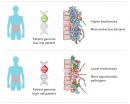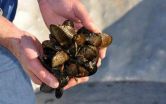The simplest element: Turning hydrogen into 'graphene'
2014-12-16
(Press-News.org) Washington, D.C.--New work from Carnegie's Ivan Naumov and Russell Hemley delves into the chemistry underlying some surprising recent observations about hydrogen, and reveals remarkable parallels between hydrogen and graphene under extreme pressures. Their work is the cover story in the December issue of Accounts of Chemical Research.
Hydrogen is the most-abundant element in the cosmos. With only a single electron per atom, it is deceptively simple. As a result, hydrogen has been a testing ground for theories of the chemical bond since the birth of quantum mechanics a century ago. Understanding the nature of chemical bonding in extreme environments is crucial for expanding our understanding of matter over the broad range of conditions found in the universe.
Observing hydrogen's behavior under very high pressures has been a great challenge for researchers. But recently teams have been able to observe that at pressures of 2-to-3.5 million times normal atmospheric pressure it transforms into an unexpected structure consisting of layered sheets, rather than a close-packed metal as had been predicted many years ago.
These hydrogen sheets resemble the carbon compound graphene. Graphene's layers are each constructed of a honeycomb structure made of six-atom carbon rings. This conventional carbon graphene, first synthesized about a decade ago, is very light, but incredibly strong, and conducts heat and electricity very efficiently. These properties promise revolutionary technology, including advanced optical electronics for screens, high-functioning photovoltaic cells, and enhanced batteries and other energy storage devices.
The new work from Naumov and Hemley shows that the stability of the unusual hydrogen structure arises from the intrinsic stability of its hydrogen rings. These rings form because of so-called aromaticity, which is well understood in carbon-containing molecules such as benzene, as well as in graphene. Aromatic structures take on a ring-like shape that can be thought of as alternating single and double bonded carbons. But what actually happens is that the electrons that make up these theoretically alternating bonds become delocalized and float in a shared circle around the inside of the ring, increasing stability.
Naumov and Hemley's study also indicates that hydrogen initially becomes a dark poorly conducting metal like graphite instead of a conventional shiny metal and a good conductor, as was originally suggested in theoretical calculations going back to the 1930's using early quantum mechanical models for solids.
Though the discovery of this layered sheet character of dense hydrogen has come as a surprise to many, chemists 30 years ago--before the discovery of graphene--predicted the structure based on simple chemical considerations. Their work is validated and extended by the new findings.
"Overall, our results indicate that chemical bonding occurs over a much broader range of conditions than people had previously considered. However, the structural effects of that chemical bonding under extreme conditions can be very different than that observed under the ordinary conditions that are familiar to us," Hemley said.
INFORMATION:
This research was supported by EFree, an Energy Frontier Research Center funded by the U.S. Department of Energy Office of Science Basic Energy Sciences. The infrastructure and facilities used are supported by the U.S. National Science Foundation and the U.S. Department of Energy/National Nuclear Security Administration.
The Carnegie Institution for Science is a private, nonprofit organization headquartered in Washington, D.C., with six research departments throughout the U.S. Since its founding in 1902, the Carnegie Institution has been a pioneering force in basic scientific research. Carnegie scientists are leaders in plant biology, developmental biology, astronomy, materials science, global ecology, and Earth and planetary science.
[Attachments] See images for this press release:

ELSE PRESS RELEASES FROM THIS DATE:
2014-12-16
MINNEAPOLIS/ST. PAUL (12/16/2014)--A new study by an international team of researchers shows for the first time that people may inherit some of the intestinal bacteria that cause Crohn's disease and ulcerative colitis, collectively know as inflammatory bowel disease (IBD). The study, recently published in Genome Medicine, also confirmed that antibiotics could worsen the imbalance in the gut microbes.
About 1.6 million Americans suffer from Crohn's disease or ulcerative colitis, according to the Crohn's and Colitis Foundation of America. Understanding the causes of these ...
2014-12-16
AMHERST, Mass. - In a follow-up to her earlier studies of learning in infancy, developmental psychologist Lisa Scott and colleagues at the University of Massachusetts Amherst are reporting that talking to babies in their first year, in particular naming things in their world, can help them make connections between what they see and hear, and these learning benefits can be seen as much as five years later.
"Learning in infancy between the ages of six to nine months lays a foundation for learning later in childhood," Scott says. "Infants learn labels for people and things ...
2014-12-16
WASHINGTON, DC--December 16, 2014--Using mathematical modeling, researchers at New York and Vanderbilt universities have shown that commensal bacteria that cause problems later in life most likely played a key role in stabilizing early human populations. The finding, published in mBio®, the online open-access journal of the American Society for Microbiology, offers an explanation as to why humans co-evolved with microbes that can cause or contribute to cancer, inflammation, and degenerative diseases of aging.
The work sprung from a fundamental question in biology ...
2014-12-16
INDIANAPOLIS -- In the first real-world trial of the impact of patient-controlled access to electronic medical records, almost half of the patients who participated withheld clinically sensitive information in their medical record from some or all of their health care providers.
Should patients control who can see specific information in their electronic medical records? How much control should they have? Can doctors and other clinicians provide safe, high-quality care when a patient's preference may deny members of the medical team from seeing portions of the electronic ...
2014-12-16
BALTIMORE, MD (Dec. 16, 2014)--With a unique, multi-faceted approach, researchers at the Lieber Institute for Brain Development (LIBD) have quantified the effect of previously unidentified anomalies in genetic expression that determine how the human brain develops from its earliest stages. Their work, published online December 15th in Nature Neuroscience, offers a novel technique for identifying biological markers in brain development that associate with risk for neurodevelopmental disorders such as schizophrenia and autism spectrum disorder (ASD).
Using state-of-the-art ...
2014-12-16
The mortality of larval Pacific oysters in Northwest hatcheries has been linked to ocean acidification. Yet the rate of increase in carbon dioxide in the atmosphere and the decrease of pH in near-shore waters have been questioned as being severe enough to cause the die-offs.
Now, a new study of Pacific oyster and Mediterranean mussel larvae found that the earliest larval stages are sensitive to saturation state, rather than carbon dioxide (CO2) or pH (acidity) per se.
Saturation state is a measure of how corrosive seawater is to the calcium carbonate shells made by ...
2014-12-16
Being "average" is often considered a bad thing, but new research suggests that averageness wins when people assess the trustworthiness of a face. The research indicates that, while typical-looking faces aren't seen as the most attractive, they are considered to be the most trustworthy. The new findings are published in Psychological Science, a journal of the Association for Psychological Science.
"Face typicality likely indicates familiarity and cultural affiliation - as such, these findings have important implications for understanding social perception, including cross-cultural ...
2014-12-16
ITHACA, N.Y. - Since 1998, hundreds and sometimes thousands of dead eider ducks have been washing up every year on Cape Cod's beaches in late summer or early fall, but the reasons behind these cyclic die-offs have remained a mystery.
A team of scientists from Cornell, Tufts University, University of Georgia, the U.S. Geological Survey and the U.S. Fish and Wildlife Service have pinned down one of the agents responsible: a pathogen they're calling Wellfleet Bay virus (WFBV). Their findings shed light on why eider ducks (also called common eiders) die on Cape Cod every ...
2014-12-16
NEW YORK, NY -- Researchers at NYU Langone Medical Center have developed new technology that can assess the location and impact of a brain injury merely by tracking the eye movements of patients as they watch music videos for less than four minutes, according to a study published Friday on-line in the Journal of Neurosurgery.
The study suggests that the use of eye tracking technology may be a potential biological marker for assessing brain function and monitoring recovery for patients with brain injuries.
Led by Uzma Samadani, MD, PhD, chief of neurosurgery at New ...
2014-12-16
GALVESTON, Texas -- In the largest study to date evaluating outcomes of Hispanic women with endometrial uterine cancer, researchers at the University of Texas Medical Branch at Galveston have found that Hispanic women in the United States were significantly less likely to survive the cancer than non-Hispanic white women.
A total of 69,764 women diagnosed with endometrial cancer between 2000 and 2010 were included in this study of public-use data from the National Cancer Institute's Surveillance, Epidemiology, and End Results Program. The study is available online in the ...
LAST 30 PRESS RELEASES:
[Press-News.org] The simplest element: Turning hydrogen into 'graphene'






